|
RIMPAC 2004:
Demonstrating Shared
Resolve for Regional Peace and Security
|
| |
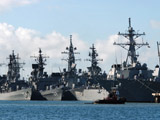 |
| |
Ships from Asia-Pacific nations — Australia,
Canada, Japan, Republic of Korea, and the United States — moor
together in Pearl Harbor, Hawaii, as part of the multinational
maritime exercise Rim of the Pacific (RIMPAC) 2004. RIMPAC enhances
regional security by improving cooperation and proficiency of
maritime and air forces of participating Pacific Rim
nations.
Photo by PH2 Richard J. Brunson,
USN |
| |
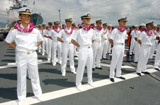 |
| |
Officers and sailors
aboard Republic of Korea destroyer Chungmugong Yi Sunshin (DDG 975)
stand in ranks on the flight deck during a ceremony welcoming them
to Pearl Harbor Naval Station for RIMPAC 2004.
Photo by JO2 Devin Wright, USN |
| |
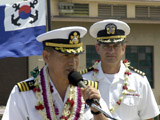 |
| |
Republic of Korea Navy
Cmdr. Lee Jin-Gyu, Commanding Officer of ROKS Changbogo (SS 061),
addresses his crew, crew members of the USS Columbus (SSN-762), and
members of the Korean American Society of Hawaii in Pearl Harbor,
Hawaii, before participating in RIMPAC 2004. Accompanying Cmdr. Lee
Jin-Gyu is U.S. Navy Capt. Dennis Murphy, Commodore, Submarine
Squadron Seven.
Photo by PH2 Justin P.
Nesbitt, USN |
| |
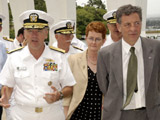 |
| |
The Honorable Robert
Hill, Australian Minister of Defence and Senator for South
Australia, and Mrs. Diana Hill accompany Adm. Walter F. Doran,
Commander, U.S. Pacific Fleet, on a tour of the USS Arizona Memorial
during RIMPAC 2004.
Photo by PH3 Victoria
A. Tullock, USN |
| |
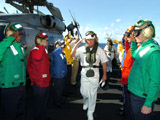 |
| |
Vice Adm. Jorge Huerta
Dunsmore, Commander of Naval Operations, Chilean Navy, arrives on
the flight deck of the USS John C. Stennis (CVN 74).
Photo by PH3 Mark J. Rebilas, USN |
| |
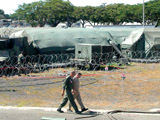 |
| |
Combined Air Operations Center
Photo by JO3(SW/AW) Kristine DeHoux,
USN |
| |
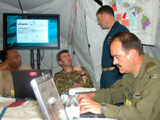 |
| |
Combined Air Operations Center
Photo by JO3(SW/AW) Kristine DeHoux,
USN |
| |
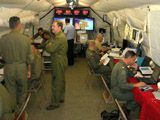 |
| |
Operating from tents at
Pearl Harbor Naval Station, members of the Combined Air Operations
Center coordinated the flight schedule for more than 100 aircraft
from seven participating nations during RIMPAC 2004.
Photo by JO3(SW/AW) Kristine DeHoux,
USN |
| |
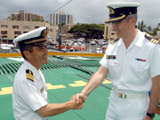 |
| |
Canadian Navy Cmdr.
Daniel Sing, Commanding Officer of the patrol frigate HMCS Regina
(FFH 334), welcomes Japan Maritime Self-Defense Force Capt. N.
Matsuura aboard the HMCS Regina.
Canadian
Department of National Defence photo by Canadian Air Force Cpl.
Joseph Morin |
| |
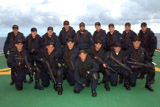 |
| |
A Canadian Navy
boarding team poses for a photo aboard the Canadian Navy support
ship HMCS Protecteur (AOR 509).
Canadian
Department of National Defence photo by Canadian Air Force Cpl.
Joseph Morin |
| |
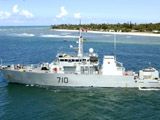 |
| |
Canadian Navy coastal defence vessel HMCS Brandon
(MCDV 710) heads out to sea to participate in RIMPAC
2004.
Photo by PH1 David A. Levy, USN |
Seven Nations participated in Exercise Rim of the Pacific (RIMPAC)
2004, the Asia-Pacific region’s largest international maritime exercise.
Held in the waters around the Hawaiian Islands, RIMPAC 2004 was the 19th
in a series of RIMPAC exercises conducted periodically since 1971. More
than 40 ships, seven submarines, more than 100 aircraft (including 21 P-3C
Orion anti-submarine and maritime surveillance aircraft from Australia,
Canada, Japan, the Republic of Korea (ROK), the United Kingdom, and the
U.S.), and almost 18,000 service members from seven nations participated
in the July 2004 exercise. RIMPAC 2004 brought together maritime forces
from six Pacific Rim nations — Australia, Canada, Chile, Japan, the ROK,
and the United States — along with the United Kingdom. Ecuador, Malaysia,
Mexico, Philippines, Russia, Singapore, and Thailand sent observers.
RIMPAC enhances the ability to respond to crises through
interoperability and cooperation of participating units in combined
operations. By enhancing interoperability, RIMPAC promotes stability in
the Asia-Pacific region. This year’s exercise included surface combatant
ships, submarines, tactical aircraft, and amphibious forces. Key training
objectives included enhanced command and control among participants;
maintenance of a common operational picture; coordination of surface,
subsurface, and air assets in a multi-submarine and multi-threat
environment; and air defense, including standardized reporting and
detection to engage a mock target.
Exercise events involved tactical proficiency, non-combatant evacuation
operations, amphibious assault, anti-submarine warfare, and humanitarian
assistance. Throughout the exercise, individual units remained under
operational control of their respective national commanders.
Opening Ceremony
Addressing
participants at the opening ceremony for RIMPAC 2004, Commodore Roger
Girouard, Commander, Canadian Fleet Pacific said, “. . . it is a real
pleasure to be here representing the Canadian team and to be back in
RIMPAC in a big way after a hiatus of two years, because of Canada’s
commitments overseas to the [Global] War on Terror. We have four ships and
aircraft participating [in RIMPAC 2004] . . . the key for us is the
opportunity . . . to see us come together, share the lessons of all the
operations we have been off to do, and work the agenda of coalition
operations together — breaking communication challenges and most
importantly sharing the knowledge and conversation that we so dearly enjoy
as naval officers and seaman. RIMPAC for us is an opportunity . . . in my
case it’s building a deployable task group. RIMPAC gives me an opportunity
to do that.”-
Commenting on the importance of RIMPAC 2004, ROK Navy Capt. Lee Gun
Doo, Commander of the Republic of Korea RIMPAC Training Group, told
participants, “The value of RIMPAC exercise and the meaning of
participation are more important than any combined exercises for the
Republic of Korea Navy. RIMPAC 2004 is a wonderful opportunity to develop
intimate cooperation and to imbue the solid allied military relationships
with nations along the rim of the Pacific.”
Also addressing the importance of the exercise, U.S. Navy Vice Adm.
Michael McCabe, Commander, Third Fleet, said, “I want to emphasize the
nature of the Global War on Terrorism, particularly for those countries
that border on the Pacific. Fully into the 95th percentile of global
economy’s trade by volume travels over sea-lanes. Some 46,000 ships of
size pass through 4,000 ports, and frankly, we don’t have the greatest
picture of what happens on the sea. We have a very good picture of what
happens in the air, but not the same picture of what happens on the sea.
So, . . . it’s very important, particularly in the Pacific, that the
navies of the world get together and work together and can communicate
well together as we focus on countering the terrorist threat, both in
terms of the movement of weapons, people, drugs; illicit trade that will
become more important as we look into the future. And so that’s a
significant part of this exercise. It always has been and it’s never been
more important than now.”
“ Exercises like RIMPAC enhance regional security while building
partnerships with our global neighbors,” noted U.S. Navy Rear Admiral
Patrick Walsh, Commander, Carrier Group Seven and Multinational Task Force
Commander for RIMPAC 2004. “This is a unique opportunity to bring our
Pacific allies together and train how to operate and respond as one
collective force.” He explained that the world we live in today requires
swift multinational attention and deliberate action when responding to
crisis. “RIMPAC is important in that it focuses on building
interoperability and cooperation with our allies and coalition partners in
the region, so we are able to respond quickly and confidently to real
world situations.”
RIMPAC 2004 Challenges
Coordinators
RIMPAC 2004 coordinators began planning the largest
military exercise in the Pacific two years before a participating ship set
sail for Hawaii. Synchronizing the efforts of seven nations and 18,000
troops is a formidable task, according to Royal Australian Navy Lt. Cmdr.
David Tietzel, RIMPAC coordinator. “The biggest challenge is getting
everyone here,” he said.
Once RIMPAC participants and all the elements were in place,
coordinators switched their focus to overcoming communication obstacles
among foreign militaries operating as a coalition force. Planners then
turned to specific exercises: landing 2,000 U.S. Marines ashore,
evacuating civilians during a humanitarian mission, conducting
anti-submarine warfare, and orchestrating live-fire exercises. “Safety is
paramount,” said Lt. Cmdr. Tietzel.
The exercise scenario involved the coalition forces (Blue), who
defended the attacked country (Green) from the attacking country(Orange)
forces. Country Purple remained neutral until tensions heightened and
Purple joined the fight. “At that point, we’re in an all-out war to help
country Green maintain its independence,” said U.S. Marine Lt. Col. Marcus
Hewett. As the scenario unfolded, military officials from Ecuador, India,
Malaysia, Mexico, the Philippines, Russia, Singapore, and Thailand
observed the exercise events. “This is a great opportunity for us to show
the world we are fighting the Global War on Terrorism,” said Lt. Col.
Hewett.
Combined Air Operations
Center
The task of the Combined Forces Air
Component Command (CFACC) was to keep the skies safe while accomplishing
the mission. The task was done by the Combined Air Operations Center
(CAOC) staff and led by the CFACC Commander, U.S. Navy Rear Adm. Derwood
Curtis, and Deputy CFACC Commander, Canadian Air Force Col. Chris
Henneberry. The CAOC, manned by 150 Australian, Canadian, United Kingdom,
and U.S. personnel, coordinated the hectic flight schedule for more than
100 aircraft from the seven participating nations.
The CAOC, located on the U.S. Navy’s Pearl Harbor Naval Station,
comprised a series of tents and mobile structures containing command,
control, communications, computers, and intelligence equipment. One tent
provided enough space for the four cells — strategy, targeting, master air
attack plans, and combat operations — to operate effectively. The close
working environment inside the tent helped build trust and camaraderie
with coalition partners. The face-to-face communications was very
effective in problem solving.
With the help of the Combined Enterprise Regional Information Exchange
System (CENTRIXS), the CAOC maintained air safety. The system provided all
participating nations a way to deliver protected information, communicate
effectively, and share information electronically via e-mail and “chat”
capabilities.
According to Col. Henneberry, who also participated in RIMPAC 2002,
CENTRIXS significantly improved communications. CENTRIXS enabled all the
exercise coalition partners to communicate using the same real-time
network and chat rooms. This gave all partners access to the Theater
Battle Management Core System used for air tasking orders (ATOs).
From planning through execution, the CAOC developed ATOs detailing each
mission flown by every aircraft from about 40 ships and various shore
facilities. “This entire operation works to develop a plan that meets the
Combined Force Air Component Commander’s objectives and, in turn, supports
the overall Commander Combined Task Force objectives through the execution
of the daily ATO and Air Control Order,” said U.S. Navy Capt. Stu
Hinrichs, CAOC Deputy Director.
Two ATO coordinators marshal each ATO through the four-day cycle during
which the CAOC cells build specifications to meet mission objectives.
Beginning with the strategy cell, the ATO then moves to the guidance
apportionment and targeting cell, then the master air attack plan cell,
and finally to ATO production, after which the ATO goes to the operations
cell for command and control of all air activity.
“ We must network with an extensive and dispersed force to ensure all
concerned have a voice in the process and have situational awareness of
the plan,” said Capt. Hinrichs. “The extensive network of communication is
critical to the process so people can insert information as feedback, and
we have the opportunity to be responsive in real time to change the ATO as
necessary and retransmit.” Posted to the coalition Web site, the ATOs
included direction for airspace management. The CAOC combat operations
cell directed and modified the ATO on a contingency basis.
Other key elements of the ATO process included rules of engagement
provided by Judge Advocate General representatives and information from
intelligence, surveillance, and reconnaissance specialists. “Intelligence
personnel are essential to help shape the battle space, to plan and
provide targeteering, and to deliver combat assessment,” explained Capt.
Hinrichs, adding, “They thread themselves throughout the entire cycle.”
Air missions included moving cargo or people, airborne refueling,
maintaining surveillance, and targeting a threat. During any particular
day, the various cells worked up to four different ATOs. Maintaining the
integrity of each ATO is vital. “They own that ATO through the whole cycle
from birth to execution,” said Capt. Hinrichs.
Coalition air force commanders had access to all information necessary
to respond to the mission from each of the participating nations through
the Theater Battle Management Core System. This is a Web-based system for
planning, managing, and executing the air war. Computer programs keep
track of the latest information on targets, weapons, fuel loads, weather,
and navigation. Commanders at all levels access the Web page and execute
the plan while preparing future operations.
While the Plans Division deals with assigning and moving aircraft, the
CAOC also includes information for intelligence preparation of the
battlefield with military and diplomatic warnings and indications of
opposing and hostile forces and their capabilities. A continuous
collection and display of information affecting the battlespace allows the
allocation of assets to the appropriate targets.
Canadian Air Force Capt. Mark Mombourquette, noted, “The CAOC
utilizes many of the same air operations procedures [AOP] that we are
quite familiar with. The scope is larger and the pace is more dynamic. Our
Canadian team is certainly gaining further experience in AOP.” Canadian
Maj. Ken Craig of the Maritime Air Component Pacific added, “What is
happening here provides a new appreciation of why we do what we do at the
Maritime Air Components located at MARPAC and MARLANT [Canadian Navy’s
Maritime Forces Pacific and Maritime Forces Atlantic]. The RIMPAC exercise
gives our people an opportunity to train as we would fight,” he said.
Determined to gain the most from the CAOC experience for Canada, Col.
Henneberry focused the efforts of his team to further develop the resident
air component capability at both MARPAC and MARLANT. At the same time,
through this experience, a new cadre of qualified air component staff will
be ready and available to integrate seamlessly into any coalition CAOC.
Col. Henneberry pointed out, “This entire facility can be transported
anywhere in the world in two C-130 Hercules aircraft. It would take very
little to expand our [Canada’s] existing Transportable Tactical
Communications Centre to replicate what is here to provide self-supported
communications, command, control, and intelligence to any combined or
joint operation to direct a medium intensity air operation.”
Commenting on the success of the CAOC, Col. Henneberry said, “Right
from the Mid-Planning Conference through the execution of the exercise,
the relationship has been outstanding. More importantly, however, has been
the high level of confidence that we have had in [the U.S. Navy] and the
level of confidence they’ve had in us . . . .” Echoing Col. Henneberry,
U.S. Navy Rear Adm. D. C. Curtis, Commander, Cruiser-Destroyer Group Five,
declared, “The CAOC has performed exceptionally. The interoperability is
the best I’ve ever seen in any coalition exercise.”
Canada had several aircraft participating in RIMPAC 2004. They included
two CP-140 Aurora maritime patrol aircraft and two CH-124 Sea King
helicopters on the guided missile destroyer HMCS Algonquin (DDG 283) and
the patrol frigate HMCS Regina (FFH 334). “While we are not the biggest
players here, bringing aircraft allows us to fly missions, participate in
the command and control, and have a say in the decision-making process,”
declared Canadian LCol McManus. “We are therefore full partners in the
process and capable of assuming leadership positions within a
multinational coalition.”
During the exercise, the U.S. Navy’s twin-hulled catamaran High Speed
Vessel Swift (HSV 2) carried and tested the Battle-Space Preparation
Autonomous Underwater Vehicle, a small, fast underwater robot that maps
the ocean bottom near the shore, detects changes in inshore conditions,
and hunts mines.
To learn more about each other, the ships exchanged crew members before
the exercise. More than 60 sailors crossed decks between the two navies.
“The cross-pollination was a huge success,” said Lt. Cmdr. King. “It just
pays dividends in the long run. We have enjoyed immensely working with
[the U.S. sailors]. The friendships that we’ve made, I’m sure they’ll
stand the test of time.”
Anti-Submarine Warfare
Huddled behind an array of computer screens, sailors operated
the U.S. Navy’s Submarine Pacific White Cell, monitoring not only the
roughly 40 ships and 100 aircraft participating in the exercise, but also
the activity of seven multinational and bilateral submarines. “The White
Cell provided primary oversight for all submarine employment in RIMPAC
2004, resolving submarine employment issues between the specific naval
communities — surface and air,” said U.S. Navy Lt. Cmdr. Lawrence
Lintz.
Four diesel-powered submarines — one each from Australia, Chile, Japan,
ROK — and three nuclear-powered U.S. submarines operated close to surface
ships from their nations. The White Cell orchestrated safe operations for
the seven submarines by separating them geographically via different grids
in the battle space, or by sharing “mutual water” with one submarine
operating deeper than the other.
The White Cell sends and receives thousands of messages while tracking
all responsible parties above, on, and below the sea. “The biggest thing
in any exercise is communication — it’s paramount,” said Lt. Cmdr. Lintz.
“The better we can communicate . . . speeds up the process of working in
the real world.”
Coalition submarine liaison officers in the White Cell coordinated
efforts between Australian, Chilean, ROK, Japanese, and U.S. forces.
“We’re a team,” said Cmdr. Felipe Parga, the Chilean Navy Submarine
Advisor. “One must never forget we train [for interoperability] in the
real world. That’s what we’re building — the ability to work together in a
real-world scenario if we need to.”
Aboard the Chilean submarine SS Simpson (SS 21) was U.S. Navy Cmdr.
Angus McColl, who served as the U.S. liaison officer. “I worked with the
Chileans in 2001 on the SS Thomson and really enjoyed it,” said Cmdr.
McColl, referring to his three weeks aboard the Chilean Navy submarine.
“Working on the Simpson gives me a chance to work on a diesel submarine,
which is not an opportunity readily available in the U.S. Navy. I find it
fascinating to see how [the Chilean Navy] conducts submarine warfare,” he
said. “The crew is very professional and dedicated. There are incredible
professionals in the Chilean Navy, and we benefit from that exchange.”
“ We train as we fight,” said Australian Navy Lt. Cmdr. Dave Tietzel.
This involved synchronizing attacks on various country Orange assets,
including sea, air, and land attacks at targets on several islands, as
well as on and below the Pacific Ocean. He added that the simulated
undersea battles against the quiet, slow, and hard-to-find diesel
submarines are vital, since many nations do not have nuclear submarine
technology. Coalition submarines successfully eliminated the danger from
country Orange submarines.
Live-Fire Exercises
Off the
Hawaiian coast, ROK, Canadian, and U.S. ships conducted live-fire
exercises. ROK guided missile destroyers ROKS Chungmugong Yi Sunshin (DDG
975) and ROKS Euljimundok (DDG 972) worked with the USS John C. Stennis
(CVN 74) in a scenario involving an unmanned, remote-controlled target
drone (BMQ-74E). The drone flew a hostile-attack pattern simulating an
enemy missile attack on the USS Stennis, which launched missiles that
successfully engaged the target.
“ The BMQ-74E flew by once for a tracking exercise,” said U.S. Navy Lt.
Cmdr. Shawn Dominguez. “On the second pass, we engaged the target by
firing two telemetry missiles.” The missiles return a reading of how close
to the drone they pass without hitting and destroying the reusable drone.
If the drone enters the missile’s blast radius, it is a hit.
U.S. Navy Operations Specialist First Class (OS1) Surface Warfare (SW)
Westly Plount worked closely with the ship’s target acquisition systems
operator to track and engage the target. According to OS1(SW) Plount, all
initial reports indicated that if it had been an actual-live missile, the
warhead would have destroyed the target. “We were tracking the contact
when at about 40 miles (64 kilometers) out, the drone dove to 50 feet (15
meters) above the water and began an intercept course with the ship,” he
said. “When the order was given to shoot it down, we launched two
missiles.”
OS1(SW) Plount noted that combined exercises are vital in today’s
global arena. “We don’t fight wars alone anymore. It’s important for us to
work with our allies, coalition partners, and friends to learn each
other’s capabilities, strengths, and weaknesses,” he said. “The more we
operate with them in practice, the better we will all be in the event of
an actual crisis.”
During the live-fire exercises, HMCS Regina (FFH 334) recorded
successful torpedo engagements, and HMCS Algonquin (DDG 283) successfully
engaged a drone with a Standard Missile.- From his flagship, HMCS
Algonquin, Commodore Girouard was responsible for all aspects of the
seagoing response to the conflict, including maritime interdiction
operations, keeping international sea-lanes open, and protecting the
coalition force aircraft carrier, troop carrier, and supply ships from
attack.
Amphibious Assault
After eliminating the threat from country Orange air and sea
assets, an amphibious attack on Bellows Beach at Bellows Air Force Station
on the Hawaiian Island of Oahu began. Coalition forces, including a
company from the Royal Australian Regiment (RAR) and U.S. Marines,
assaulted the beach in armored attack vehicles and Landing Craft Air
Cushions from the USS Rushmore (LSD 47) and the amphibious assault ship
USS Tarawa (LHA 1).
Helicopters from the USS Tarawa flew over simulated country Orange assets
to deliver forces as part of the invasion force. “We’re pleased with the way
it progressed and we’re pleased with the coverage,” said Lt. Cmdr. Tietzel.
“Everyone involved is getting good training. We’ve come a long way in being
able to talk with each other,” he continued. “Now, we’re able to talk at the
level we’ve always wanted to before. We don’t let little things stop us. We
find ways around problems.”
Non-Combatant Evacuation Operation
Australian and U.S. forces conducted a non-combatant evacuation
operation (NEO) exercise at the Pacific Missile Range Facility on the
Hawaiian Island of Kauai. A building on the range served as an American
Consulate where evacuees waited for rescue. Protesters from the fictitious
host nation hurled epithets at the gate. Agitators from an unfriendly
neighboring country posed a looming terrorist threat; and a seasoned
ambassador conducted tense negotiations.
Royal Australian Regiment (RAR) soldiers added to the realism and
complexity of the NEO by role-playing both allied forces and evacuees, some
of whom simulated opposing force infiltrators. “For my NCOs
(non-commissioned officers) and my officers, they’ll get to see how an
American evacuation operation works — but this time from the inside,” said
RAR Maj. Tony Kaine. “The primary aim for this exercise is to develop
interoperability between the RAR and the Marines and for us to develop
expertise in amphibious operations in training areas and with equipment we
don’t have access to in Australia,” he said.
Initially, a forward command element (FCE) moved ashore to assess the
situation and provide the mock ambassador — played by retired U.S.
Ambassador Edward Marks — with options for security and evacuation. Aided by
Denis Reynolds, a special agent from the U.S. State Department’s Bureau of
Diplomatic Security, and U.S. Navy Capt. Timothy Murray, the FCE Officer in
Charge, Ambassador Marks role-played every option available to calm the
situation. He then called for the NEO when the threat to American citizens
increased.
A number of planned training evolutions occurred, including many
responses to improvised explosive devices and conducting safe transportation
despite raids by opposing forces. U.S. Marine Capt. Gary Humphries noted
that the “free-thinking” encouraged in the scenario forced NEO participants
to make on-the-spot decisions. The Evacuation Control Center processed all
mock evacuees through receiving, search and baggage control,
administration/registration, and embarkation.
“ The mission is to rapidly, accurately, and safely process evacuees in
order to facilitate non-combatant evacuation operations,” said U.S. Marine
2nd Lt. Marshall Lewis. Additional stations available, if needed, included a
detention center, Judge Advocate General consultation, and medical
evaluation. “We’re going to provide organic support to our folks and then
provide medical care for any evacuee who might need it,” said U.S. Navy
Chief Hospital Corpsman Jeffrey Smith. “We would be concerned about
preventative medical care. I’d have to ensure we only took in food and water
from safe sources,” he added.
U.S. Marines safely transported all 160 role-players via helicopter to
the USS Tarawa (LHA 1) for processing. “We search just like customs — no
fruits, vegetables, animals, or arms,” said U.S. Navy Lt. Cmdr. Dan
Granados. Tarawa’s receiving stations mirrored those ashore regarding
administration/registration, baggage control and medical, but also included
attempts to comfort the evacuees, and provide food, drink, and berthing
assignments.
Japanese P-3 Orion Crew Trains with U.S.
Navy
“ During RIMPAC we train with the U.S. Navy.- This enables us to
create new friendships and enhance our relationship with the United States,”
said Japan Maritime Self-Defense Force (JMSDF) Lt. Cmdr. Shuichi Tsurusaki.
In Japan, aircraft crews must train in very confined areas, and because
they are strictly a self-defense force, training with other nations is rare.
“We are very lucky to get this chance to train abroad.- Only a few of us
ever train outside of Japan,” said JMSDF Lt. Yusuke Kito, a P-3 pilot.
Aside from RIMPAC, the Japanese P-3 crew enjoyed sightseeing, cultural
exchanges, shopping, and playing golf.- “The golf is great!- On base in
Hawaii, I can play for one tenth the price of what I pay in Japan,” said
Chief Petty Officer Nobuhiro Sawano.
JMSDF Lt j.g. Katsuo Hirano enjoyed mingling with people of different
backgrounds. “I love the cultural diversity in America.- I speak some
Chinese so I really enjoyed Chinatown in downtown Honolulu,” he said.
Chefs At
Sea
Meals on a Japanese ship are not very
different from those on U.S. ships. While some meals are traditional,
officers and sailors aboard the Japanese Maritime Self-Defense Force
(JMSDF) destroyer JDS Haruna (DDH-141) enjoy a variety of international
flavors while at sea. A typical meal on the Haruna consists of a meat
course, vegetables, pickled vegetables, and steamed rice.
“ We serve rice with every meal, but our cooks make many kinds of foods
at sea — European, French, Chinese,” said JMSDF Public Affairs Officer Lt.
Taijiro Omata. They also have spaghetti night. Japanese cooks, like U.S.
Navy culinary specialists, go to school to learn their trade. The food is
often flavored with various soy-based sauces. The JMSDF chefs use a lot of
vegetables, beef, pork, chicken, and seafood in their cooking.
A traditional Friday lunch for Japanese sailors consists of curry rice.
In the past, the Imperial Japanese Navy served rice to let sailors know
what day it was. “They would work hard all week,” Lt. Omata said. “Sailors
would forget what day it was. Curry rice let them know they get the next
day off.”
A delicious curry roux (sauce) surrounds mixed pieces of chicken or
pork, potatoes, onions, and carrots, served over rice. Originally not a
Japanese dish, curry rice was adapted from British Navy stews and the
spice trade. “We serve hamburgers too,” said Lt. Omata. “The crew likes
the variety.”
PACFLT Band hosts Royal Australian Navy
Band for RIMPAC
For the first time in RIMPAC’s
exercise history, members of the Royal Australian Navy (RAN) Band
performed with the U.S. Pacific Fleet (PACFLT) Band at change of commands,
retirement ceremonies, and for local audiences.
“ One thing I’m really blown away by the U.S. Navy is how many people
they have and the large amount of resources they have,” said RAN Able
Seaman (AB) Musician Isaac Lo, piano and side drum player for the RAN
Band. “I think there is just so much more that you can do with such a
large number of people.” “They’re a very good, strong, professional band,”
AB Lo added. “I’ve been really interested in their management structure
and how they do business. I’ve learned a lot from them.”
“ Australia has always had strong ties and a significant relationship
with the United States,” said RAN AB Musician Lachlan Macfie, bass guitar
and drum player for the RAN Band. Seaman (SMN) Musician Carl Riseley, RAN
band trumpet player, echoed this thought when he said, “I think the
biggest thing we’ve done here is form a strong bond between the American
and Australian bands. We’ve been staying at their homes and hanging out.
Now there is quite a strong bond.”
“ It has been a great pleasure having [the RAN band members] here,”
said PACFLT Band’s Senior Chief Musician Robert Bowman. “They have made a
lasting impression on us. They’re very talented musicians and they’re good
sailors. But above all that, they’re nice people. We’re going to miss
them.”
Canadians Celebrate Canada Day
The crew of the HCMS Regina (FFH 334) brought
their hockey sticks to celebrate Canada Day under the Hawaiian sun. Eight
teams totaling about 70 Canadian Navy sailors tested their mettle in the
tropical heat in an intense battle to claim the ship’s Inter-Mess Sporting
Events Championship Trophy, while celebrating the anniversary of the
formation of the union of the British North America provinces in a
federation under the name of Canada on July 1, 1867.
“ It’s awesome, especially on Canada Day,” said Canadian Navy AB
Charles LeBlond. “It’s fun to bring a little bit of our culture with us.”
“This is our way to show our Canadian pride,” said Sub-Lt. Jae Hwang. The
Esquimalt, British Columbia-based crew wanted to show Canada Day in style
to the six other navies participating in RIMPAC 2004 said Lt. Cmdr. Art
McDonald, Regina’s executive officer. “We thought on Canada Day what would
be more [appropriate] than ball hockey.”
The Canadian teams, who are normally accustomed to skating on ice with
a puck, ran around in tennis shoes and batted an orange rubber ball on an
outdoor rink. Some nursed cuts and scrapes after falls, but played on,
battling hot and humid temperatures. “It’s totally different,” said
Sub-Lt. Hwang. “It’s almost like a different game.” Ordinary SMN Merk
Laughland noted, “Everybody just loves to play it and we try to get as
much in as possible. A lot of us have grown up playing it, so a lot of us
are pretty good at it.”
But the heat was hard to ignore, especially for sailors from a country
that is known for its snow. “A lot of us are thirsty out here,” said SMN
Laughland. “We’re having to drink a lot of water.” Others didn’t mind.
“It’s the first time I’ve seen palm trees,” noted Sub-Lt. Hwang. “I’m just
enjoying every moment of it.” The Canadian sailors, who continued the
national day of celebration with a lunchtime barbecue and an evening
reception aboard the ship, said they appreciate the U.S. Navy’s
hospitality. “We really feel at home with our American cousins,” said
Sub-Lt. Nicholas Woloszczuk.
Conclusion
RIMPAC 2004
was an excellent opportunity for participating forces to improve tactical
capabilities and significantly increase interoperability between
participating units. RIMPAC provided an environment to hone critical
maritime skills, such as anti-submarine warfare; practice combined
operations; and learn new lessons. The ability to operate in a major
exercise involving many coalition partners enhances combat readiness
levels and improves coalition command, control, and communication
procedures.
|